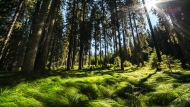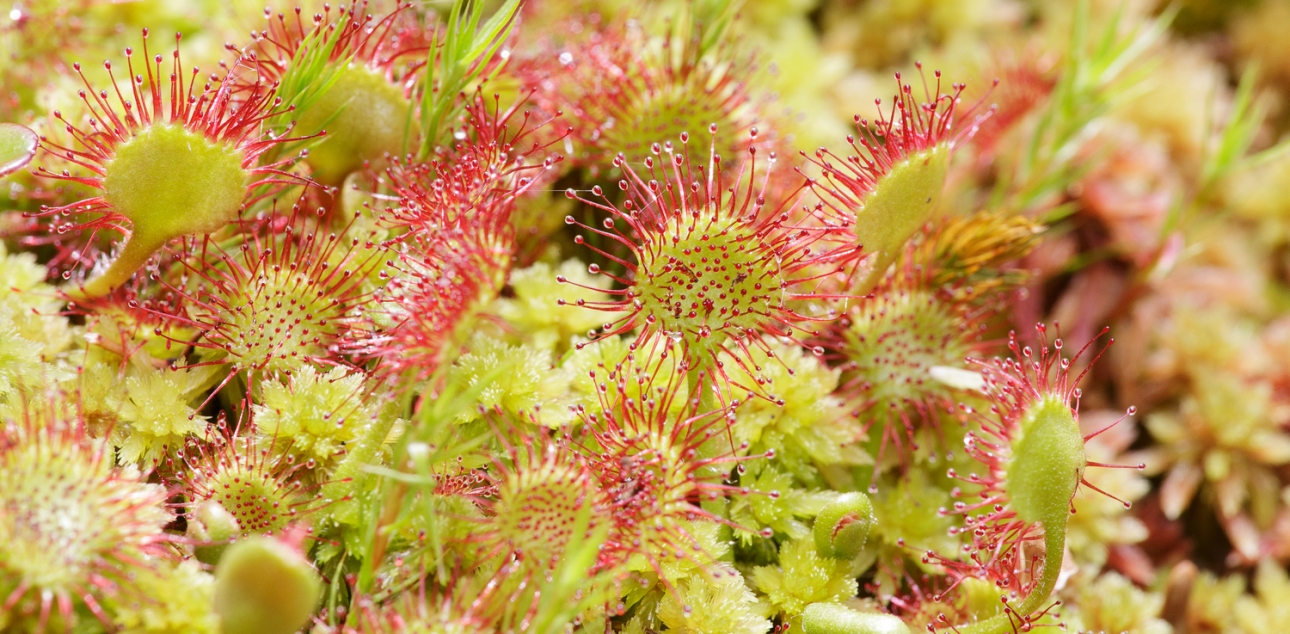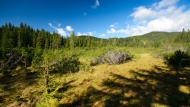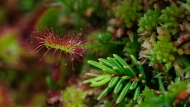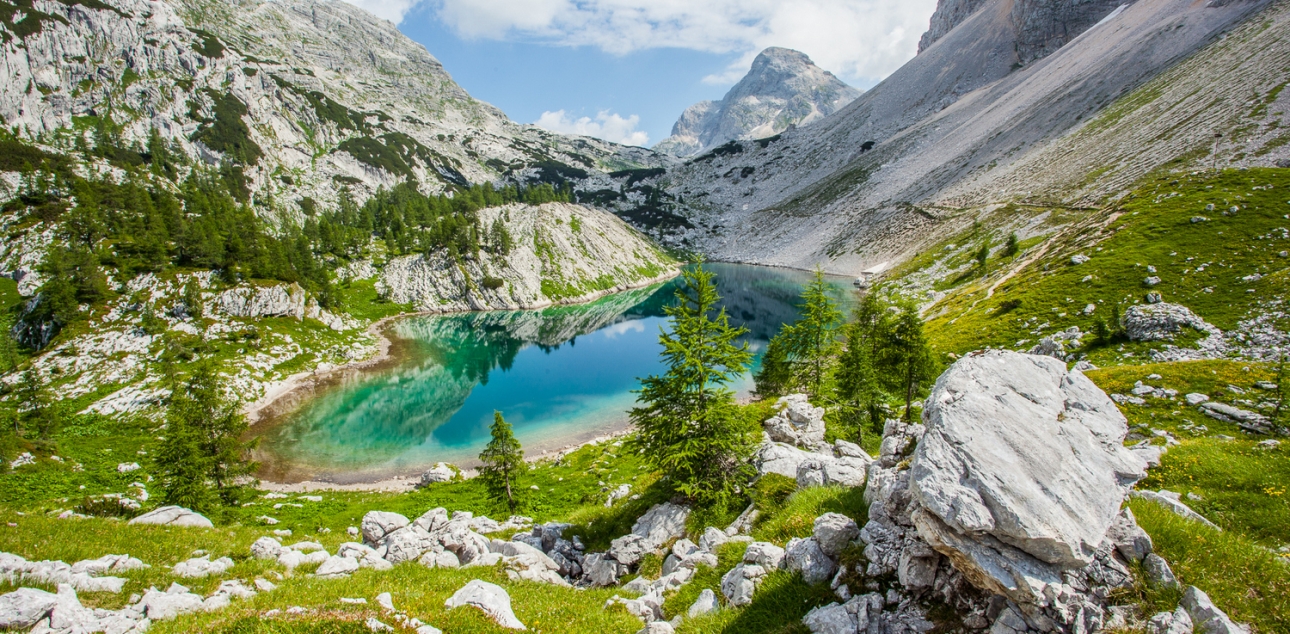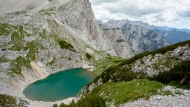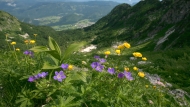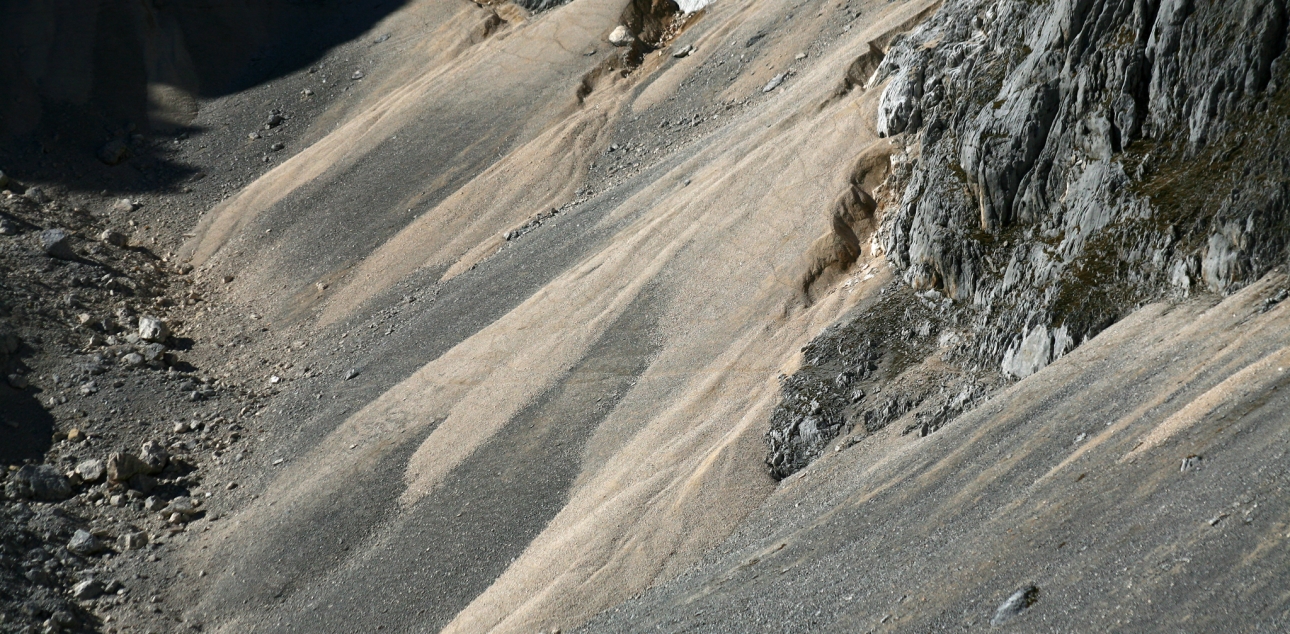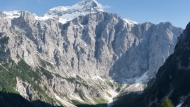Forests
The forest covers two thirds of the Park’s territory, overgrowing valley floors, steep slopes, and high-altitude plateaus. The most characteristic tree species in the Park are beech, spruce and larch. Although the Alpine environment is normally associated with spruce, larch and dwarf pines, stands of thermophilous hop hornbeam and dwarf ash are a common feature of the Julian Alps.
Only the species and specimens which have adapted to the harsh conditions governing these areas can survive in the mountains. On the Soča side of the Park, the tree line does not exceed 1,600 m. The tree species which reaches the highest altitude is beech, which favours cloudy weather with and high precipitation, but does not reach as high as spruce and larch. It is worth noting that prior to the onset of iron foundries these plateaus were overgrown with beech forests. Further inland and to the north, spruce and larch become more common and in the upper vegetation belt exceed the altitude of 1,800 m.
The largest plateaus in the Park, namely Pokljuka and Mežakla, are covered mainly in spruce forests. The dark undergrowth is home to few species: fir clubmoss (Huperzia selago), small cow-wheat (Melampyrum sylvaticum), woodrush sedge (Luzula luzulina), one-flowered wintergreen (Moneses uniflora) and several mosses. Bushy lichens are an indicator of clean air.
Connected woodlands are home to a variety of animal species. In early May mornings we can hear the mating call of the black grouse (Tetrao urogallus) or rejoice in the liveliness of a squirrel (Sciurus vulgaris) jumping from one tree to another. Ant-hills composed of tree needles offer shelter to forests ants. Deer and red deer are common residents of these forests.
Peat bogs
On the Pokljuka plateau, nestled within the extensive forests of the Triglav National Park, lie special ecosystems – peat bogs. Bogs are areas of stagnant water, covered with a layer of peat ranging in size from several decimetres to several metres and overgrown with peat mosses.
The process of bog creation started after the last glaciation period. The glacier receded, leaving small lakelets behind. Over thousands of years, these filled with organic debris up of aquatic plants populating the lakes. Increasingly acidic water promoted the growth and development of certain plants.
The area was settled by bog mosses, which are still the predominating species overgrowing the bog surface. Bog mosses take roots in the upper layers, and carbonise in lower layers. The surface grows upwards steadily, creating a typical dome-shaped form of a raised bog. Apart from acidic soil, peat bogs are also characterised by low nutrient supply and high differences in temperature.
During evolution, plants have adopted different methods to adapt to these conditions. Several species have developed the ability to trap and eat animals, others obtain nutrients through their partnership with fungi. Plants store water inside special cells, in tissue, or in specially adapted organs. In order to minimise water loss, several plants have developed thick waxy leaf surfaces or extensive root systems
Most animals observed in a bog may otherwise be residents of other wetlands, nearby forests or meadows. Permanent bog residents include several species of dragonflies, true bugs, butterflies, water beetles, and mosquito larvae.
The peat bogs on the Pokljuka plateau are the southernmost lying raised bogs in Europe. In lower-lying areas, bogs were destroyed by drying to make agricultural land and for making firewood. A highly sensitive ecosystem, peat bogs are protected under the EU legislation and included in the NATURA 2000 network.
See the Goreljek Peat Bog Educational Trail.
Streams and rivers
Powerful karst springs rise from valley bottoms. Where water drops over a ledge, a waterfall is created. Springs grow into streams which can erode deep into the surface and create steep mountain ravines, gorges, canyons and troughs. The waters which fill them are torrential in character. They rise quickly after heavy showers and run dry during drought.
The temperature of the water in the springs remains constant throughout the year and is equal to the average yearly temperature of the nearest settlement. In Alpine areas the temperatures are very low. Due to hard living conditions only small algae, mosses, and insect larvae are able to survive in these water bodies.
Life forms are scarce in the upper stream due to the speed of water; however, one can find all sorts of organisms lower downstream where calm pools appear. Once the water leaves the narrow mountain passages, it pours out over U-shaped valleys. The largest rivers in the Park are the Sava Bohinjka, Sava Dolinka, and Soča. Alder trees and willow trees grow on river banks, pioneer communities can be found on gravel sites and the water abounds in fish.
This fragile habitat is endangered because of human interventions with diverting watercourses, as well as a result of various sports activities and waste water discharge.
See the park trails: Triglavska Bistrica Trail, Soča Trail, Tolmin Gorges.
Alpine lakes
Alpine lakes at high altitudes are often covered with ice for more than half a year. Most lakes are small, and therefore highly sensitive and vulnerable living environments. The lakes are home to different species of algae, microscopic shrimps and insect larvae. Fish are foreign to this environment and can disturb the natural balance.
Fish were first introduced into Lake Krn and then to Jezero na Planini pri Jezeru, Črno jezero and Dvojno jezero (the Double Lake). The fish first fed on plankton shrimps. When the supply ran out, they took to small-sized and bottom-living invertebrates, mainly mayflies and caddisflies. These species controlled the spreading of algae in the past but when they were wiped out by fish, this enabled algae and other aquatic plants to slip out of control and in a few years a previously clear lake turned into a yellow-green stew.
Besides the fish, lakes are adversely affected by increased number of bathers. In hot summer days, many hikers decide to refresh in the cool water of the lake. However, we should know that during bathing our bodies produce sweat that comprises nutrients, and nutrients are the primary cause of deteriorating conditions in Alpine lakes. Every bather releases about 1 milligram of phosphates per bathing session, and occasionally other human body products are discharged into the lake. Additionally, water washes off sun lotions and creams off our bodies.
All Alpine lakes lie within the first protective regime of the Triglav National Park, where bathing is prohibited due to its detrimental effects, and is considered an offence. Therefore we urge you to reconsider bathing in Alpine lakes: think about all the consequences that your act will impose on the animate and inanimate nature of the lakes and their surroundings. To cool off, visit one of many bathing areas or swimming pools in the valley. This will greatly contribute to the preservation of water bodies in the Alpine territory.
High-altitude meadows
Flower-rich Alpine meadows are a riot of colours. The first flower to peep out, even when there is still snow, is the Alpine snowbell (Soldanella alpina). Soon after that a regular flower show follows where a great number of the alpine flora representatives can be seen. Gentians (Gentiana sp.), beaked lousewort (Pedicularis rostratocapitata), sun rose (Helinathemum nummularium), edelweiss (Leontopodium alpinum), black vanilla orchid (Nigritella nigra), carnation (Dianthus sp.) and many others form an incredible colour palette.
We can often see the alpine salamander (Salamandra atra) on mountain pastures in moist weather. As there is no water, the young ones develop inside the female where they also metamorphose. They feed on worms and snails. The largest butterfly to inhabit the Triglav National Park – apollo (Parnassius apollo) – can be seen in sunny pastures.
Whenever you see numerous holes dug in the earth, look around for marmots (Marmota marmota). The marmot is a herbivore just like the mountain hare (Lepus timidus), which is normally brown, but in winter its fur changes to snow-white. The rock ptarmigan (Lagopus mutus) also changes colour to white in winter. The bird digs up tunnels underneath the snow where it can survive the unpleasant weather conditions.
The largest inhabitants of high-altitude mountains are chamois (Rupicapra rupicapra) and ibex (Capra ibex). The chamois is smaller and numerically superior. After the ibex was exterminated in the 17th century, it was reintroduced in the years 1964-1975. The male is adorned with up to one metre long antlers weighing 6-14kg. Man is a frequent visitor of these areas.
See the website of the Alpine Botanical Garden Juliana in Trenta.
Screes
Scree is a collection of broken rock fragments that has accumulated through periodic rockfall from adjacent rock faces resulting from mechanical weathering and unstable bedrock. In just one day, several hundred kilograms or even tons of rock fragments change their position.
Scree is a challenging habitat for plants, which have developed a variety of strategies to survive in these extreme conditions. Strongly-developed root systems enable them to root better in the unstable terrain. These plants fight sudden deposition of rocky debris by extending their stems, and thick leaves protect them from damage. Normally, scree species root fast and easily.
Scree vegetation includes the association of round-leaved penny-cress (Thlaspi rotundifolium) and Julian poppy (Papaver ernestii-mayeri), along with the Alpine toadflax (Linaria alpina) and Alpine poppy (Papaver rhaeticum). Chamois and ibexes are often seen grazing on scree slopes.
Rock clifs
The highest mountain ridges in the Triglav National Park are over 2000m high. Interrupted by steep walls and precipices, these mountains are not easily accessible. The shape of the peak depends on the geological structure of the mountain and external factors. Some ridges are serrated, while others willingly accommodate narrow paths. Secure climbing trails leading to their summits are only intended for experienced mountaineers.
Weather is very unpredictable in these heights. Strong winds and snow are not unusual even in summer months. Water seeping into cracks and freezing there makes this a brittle and unstable territory. Living conditions are very harsh, but even here small creatures have found their home.
The highest growing plant in the mountains is the community of the Triglav rose (Potentilla nitida). Next to this dazzling flower you can also find the Alpine fescue (Festuca alpina), sandwort (Minuartia cherlerioides), Alpine forget-me-not (Eritrichum nanum), saxifrage (Saxifraga crustata) and Swiss jasmine (Androsace helvetica). They all have distinctive cushion-like growth and extremely variegated flowers.
In the fissures we find our only bellflower with a closed sepal - the Zois' bellflower (Campanula zoysii). It was named after botanist Karl Zois. Higher in the mountains where the living conditions are extremely difficult, only algae and lichens that grow on barren stone terrain can be found.
Rock cavities are a popular nesting site for the alpine chough (Pyrrhocorax graculus). These skilful flyers are often seen soaring among summits. The alpine swift (Apus melba) and the wall creeper (Trichodroma muraria) can be found among the steep rocks.
With some luck we can also spot the golden eagle (Aquila chrysaetos). Only a few pairs nests in the Triglav National Park area. The eagle’s pray is sometimes heavier than the bird itself; therefore, eagles often nest in sites which are lower in elevation than their hunting grounds. This makes it easier for the bird to take the prey into its nest.






